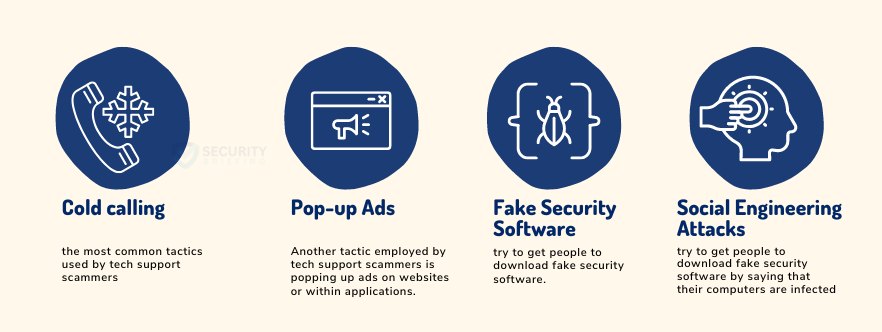Tech support scams
February 13, 2023 • César Daniel Barreto

It’s no secret that the Internet can be a dangerous place. To protect yourself, you need to know what’s out there and how it might target you; tech support scams are just one of those risks. In this blog post, we will give practical advice on how to avoid becoming a victim, as well as tips for staying safe online going forward, so nothing catches you by surprise. With all these resources at your disposal, don’t become another statistic in the growing epidemic of cybercrime!
What are tech support scams?
Tech support scams are a type of cybercrime where people pretend to be from technical support in order to steal personal information or money from people who don’t know what’s going on. These scammers employ various tactics, such as cold calling, phishing emails, or infecting a victim’s device with malware. The ultimate objective is to extract sensitive information or financial resources from their targets. It is crucial to be aware of these scams and to protect your personal information and financial assets.
Common tactics used by scammers

Tech support scams are becoming more common, they are frequently carried out via social engineering techniques such as cold calls and phishing emails. These scams may also employ scare tactics, such as falsely claiming that the victim’s computer is compromised then offering their “assistance” for a price.
The following are the most frequent tech support strategies:
Cold calling: One of the most common tactics used by tech support scammers is cold calling.
This is done by calling people at random, often saying they are from a real tech company or service provider, and trying to convince them that malware or other bad software is on their computer.
They will then offer to fix the problem for a fee.
Pop-up Ads: Another tactic employed by tech support scammers is popping up ads on websites or within applications.
These ads can look like fake security warnings or notices that there are viruses on your computer. They will tell you to call a number in the ad to get help getting rid of the viruses.
Phishing emails: Phishing emails are another way tech support scammers try to gain access to personal information and money from unsuspecting victims.
Most of the time, the links in these emails take people to bad websites where they are asked for sensitive information like credit card numbers or passwords.
Fake Security Software: Tech support scammers may also try to get people to download fake security software by saying that their computers are infected with malware and need to be protected from more threats.
The software itself may actually contain malicious code, which could damage your system even further.
Social Engineering Attacks: Social engineering attacks involve using psychological manipulation techniques such as creating fear or urgency in order to persuade someone into giving up confidential information or taking certain actions (such as paying money).
For example, a scammer might claim that your computer needs urgent repairs due to a virus infection, but they must be paid for before work can begin.
Protecting Yourself from Tech Support Scams
Tech support scams are a growing problem in the digital age, and it’s important to be aware of these scams and take steps to protect yourself from them. Here are some tips for avoiding tech support scams:
- Don’t give out personal information or access your computer without verifying the identity of the person contacting you first.
- Be wary of unsolicited emails, phone calls, or text messages claiming that there is an issue with your device or account.
- Don’t click on links in suspicious emails or download attachments unless you are sure they are legitimate.
- If someone contacts you claiming to be from a reputable company such as Microsoft, Apple, Google, etc., hang up and contact the company directly using their official customer service number listed on their website instead of using any numbers provided by the caller.
- Ask questions about who they work for before providing any information about yourself or allowing them remote access into your computer system.
- Trust your instincts and don’t provide any personal information until you have verified their identity first.
- Hang up immediately if anyone tries pressuring you into giving away sensitive data such as passwords or credit card numbers over the phone without confirming who they are first.
- Recognize suspicious emails and phone calls by looking out for red flags such as unsolicited contact, urgent requests for personal information, promises of free services or products in exchange for payment upfront, and threats of legal action if payment isn’t made quickly.
- Pay attention to spelling mistakes and grammar errors, which may indicate that the email is not genuine.
By taking these steps, you can avoid becoming a victim of tech support scams and protect yourself from fraud.
Reporting Tech Support Scams
If you happen to come across a tech support scam, it is important to be vigilant and take action to prevent others from becoming victims of this crime. Unfortunately, some people have lost all their savings as a result of this horrible fraud. To help combat this problem, it is crucial that you report any tech support scams you encounter. Here are some steps you can take to report a tech support scam:
- Report Online Frauds and Phishing Attempts: If you suspect an email or website is part of a tech support scam, report it to your local law enforcement agency or the Federal Trade Commission (FTC). (The FTC also provides resources for victims of identity theft on their website).
- Report Phone Calls and Text Messages: If you receive a phone call or text message from someone claiming to be from tech support, hang up immediately and Contact your cell phone provider.
- Report Unauthorized Charges: If you find unauthorized charges on your credit card statement or bank account due to a tech support scam, contact your financial institution immediately. Try to obtain proof of purchase, such as an invoice number, to help with the investigation.
Staying Safe Online
Cyber threats like tech support scams pose a significant risk, so it’s critical to protect your devices and accounts. Here are some best practices for remaining safe online:
Securing Devices and Accounts
- Keep all internet-connected devices, such as computers, phones, and tablets, updated with the latest security patches.
- Install a reliable antivirus program and firewall on each device to protect against malicious software.
- Enable two-factor authentication whenever possible for added protection.
Creating Strong Passwords
- When creating passwords, make sure they are strong and cannot be easily guessed.
- Use a combination of upper case letters, lower case letters, numbers, and symbols to create unique passwords.
- Consider using a password manager to generate and securely store random passwords.
Stay informed and aware of the latest cybersecurity trends to ensure your data remains secure. Take advantage of resources available for learning more about cyber safety.
Resources for Learning More About Cybersecurity and Safety Online
The U.S. government provides several resources to help individuals learn about cybersecurity and safety online. The Department of Homeland Security offers the StopThinkConnect campaign, raising public awareness about cyber threats and providing tips on safety. The National Cybersecurity Awareness Month initiative is held every October, educating citizens on how to protect themselves from cyber attacks.
Professional Organizations Dedicated to Cybersecurity Education and Research
The Information Systems Audit & Control Association (ISACA) is a global non-profit that offers guidance on best practices for information security management, risk assessment, audit techniques, compliance standards, privacy protection measures, and data analytics tools. They also provide incident response strategies through their publications and the Certified Information Systems Auditor certification program.
Conclusion
Tech support scams endanger the security of our digital information. To defend ourselves, we must stay aware on cybersecurity, invest in anti-virus software, and maintain our computers up to date. By taking these procedures, we can protect our data from tech support frauds and maintain internet security. Take control of your cybersecurity immediately and begin defending yourself.
FAQs
ech support scammers pose as representatives from well-known companies, such as Microsoft or Apple, and attempt to gain access to the victim’s computer. They may ask for payment or install malicious software once they have access.
To protect yourself from tech support scams, never give out personal information or payment details over the phone or online. Don’t click on links from suspicious emails or websites. If you think your computer has been infected, run an anti-malware scan and delete any malicious files found. Keep all software up-to-date to better detect and remove threats.
Common tech support scams involve criminals posing as legitimate tech support representatives and using tactics like cold calls, pop-up messages, and fake websites to gain access to personal information or money.
Tech support scams come from malicious websites, phishing emails, and cold calls. The scammers may create fake websites, send mass emails, or call unsuspecting users directly, claiming that their computer is infected with malware.
César Daniel Barreto
César Daniel Barreto is an esteemed cybersecurity writer and expert, known for his in-depth knowledge and ability to simplify complex cyber security topics. With extensive experience in network security and data protection, he regularly contributes insightful articles and analysis on the latest cybersecurity trends, educating both professionals and the public.